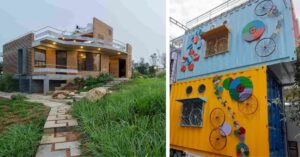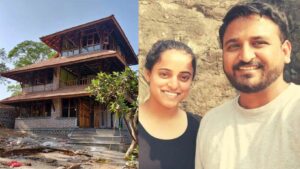Architects Behind Bengaluru’s Zero-Waste Sustainable School Built Around Sprawling Trees
Built by architects Saurabh Gupta and Akanksha Gupta, the EuroSchool near Bannerghatta National Park in Bengaluru imbibes sustainability at its core, and aims to impart learning immersed in nature.

What do you picture when you think of a school? Drab corridors lined with classrooms on either side? Perhaps a canteen and a dried up playground? Monotonous routines and little to no nature around?
The EuroSchool Bannerghatta in Bengaluru begs to differ. Teeming with lush green gardens, a rainwater harvesting channel, a terrace that opens to tree tops for the children to play on, and much more, this school shows why learning happens beyond the classrooms, and with nature at its core.
“Our design attempts to make the learning environment more fun and immersed in nature. The designs of the classrooms and other rooms are made in a way that they blend with the nature outside,” Saurabh Gupta, the architect of the building, tells The Better India.
Bringing nature to children
When Akanksha Gupta and Saurabh Gupta of Vijay Gupta Architects were approached by the school to build a school on the 20,000 square metre site in the backdrop of the Bannerghatta National Park, the duo knew that this project was going to be different.
“It is a lush green site with Bannerghatta Park close to it. The land had so many trees and plantations, and we did not have the heart to let it all be converted into a concrete building,” says Saurabh.
“So we wanted to create something that does justice to the land and the city of Bengaluru, in the sense that the place has always been nature-loving,” he adds.
“The children have the freedom to step out and learn with nature. For instance, they won’t just learn that rainwater harvesting exists, they can actually see it happening on their school campus,” he says.
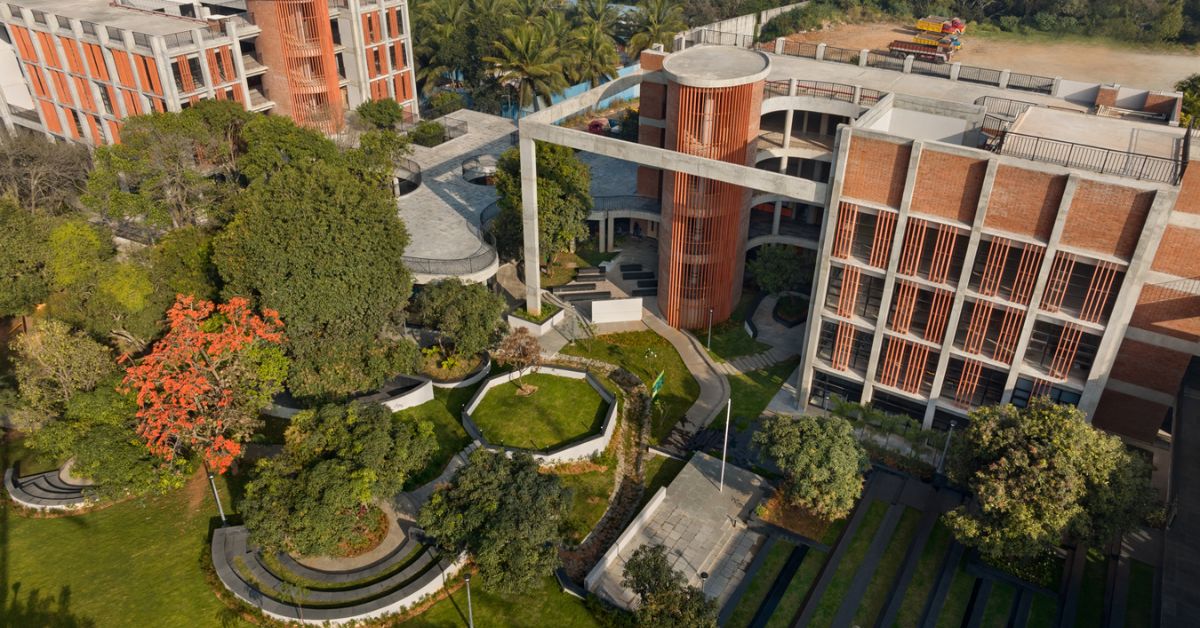
“I believe a school like this is important because children do not get a chance to go out in the wild. As children, we had the freedom and opportunity to just be in nature, but kids nowadays spend most of their time on gadgets,” he explains, adding that the only place they spent time without them is in school.
“I think school is the best place for kids to spend their time in nature too,” he notes.
Saurabh and Akanksha have pursued their mission of sustainable architecture for years. “Many of our projects are green certified. One of our earliest school campuses was the BRCM school in a semi-arid zone of Haryana, constructed in the 1980s and built around sustainable ideas to reuse and recycle water to create a green oasis in the middle of the desert. We believe that sustainable development is important for the future,” says Akanksha.
‘Outdoor spaces to learn in and from’
The design uses the vegetation and natural features of the school to its advantage, with trees becoming the focal points within the building’s design. “Ninety per cent of the trees on the property were saved from being chopped down. The school campus moves around the trees and vegetation,” he says.
The trees grow throughout the building, creating transitional spaces between classroom clusters, courtyards, activity zones, walkways, and congregational areas, providing a green and refreshing environment.
“To achieve this, we created various outdoor spaces for the students to learn in and from. For instance, we have outdoor classrooms to encourage students to observe, learn and interact with their environment,” he says.
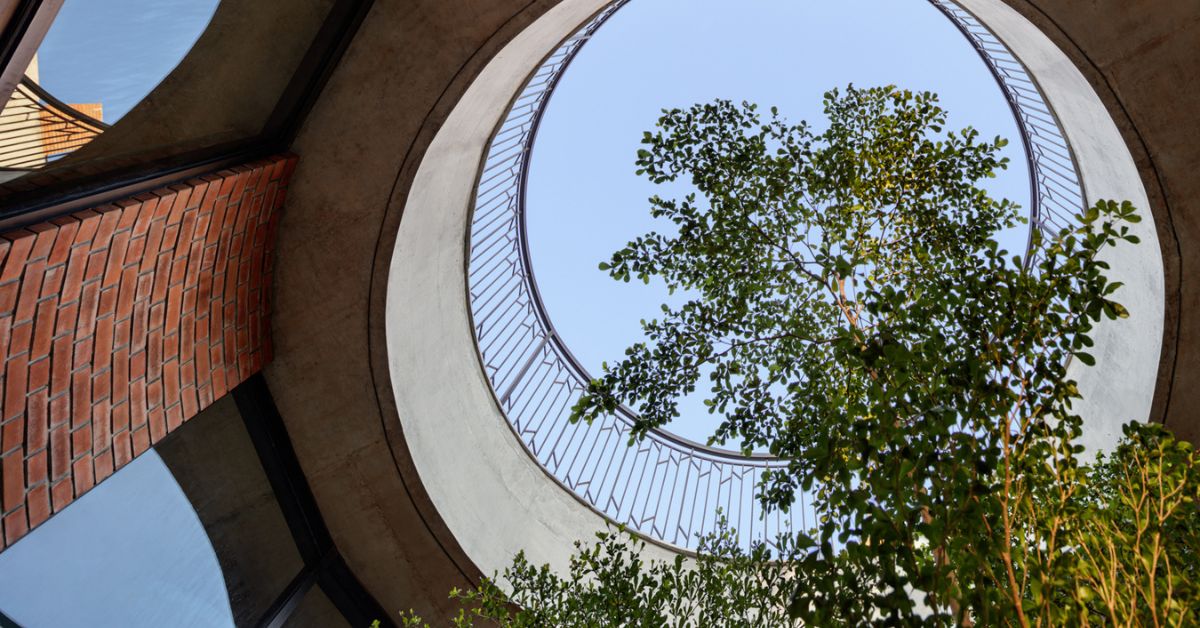
The cafeteria of the school stands beside a gardening patch next where students can understand where the food they consume comes from, while also helping take care of the plants. “The land had a channel of water running through it and we decided to restore it. The school also has a plantation area where they grow their food and the produce is utilised in the cafeteria,” he says.
The school also has a very unique play area on the terrace.
“The building was designed in a way that the terrace of the building comes at par with the treetops. The terrace is in sync with nature with leaves peeking out of punctures in the floorplate, allowing children the opportunity to play among the treetops,” says Akanksha.
The children are free to climb the trees and pluck the produce too. “This gives them a space to live a childhood that is much more than just gadgets and television. The environment that they might see on screens is a reality in the school,” says Saurabh.
Bringing sustainability out of textbooks
While the architecture of the building complements and blends into the greenery on the grounds, the building materials sing in harmony with nature. “Preserving the existing nature was one of our first goals while designing the property. There were fruit trees such as mango and jamun, which are still growing on the grounds,” he says.
As for the materials, the duo tried to upcycle, recycle and reduce waste as much as possible.
“When the architecture of the place is so in harmony with nature, the materials had to be too. All the steel used in the construction of the building is upcycled and locally sourced. On the facade of the building, we used exposed brickwork. The reason was that it is fairly permanent in nature so the life cycle of the building increases. You don’t have to keep painting it up every year,” he says.
Taking the idea of sustainability forward, the school is a zero-waste campus that has a sewage disposal system, and harvests 1.5 lakh litres of rainwater besides children growing their own food.
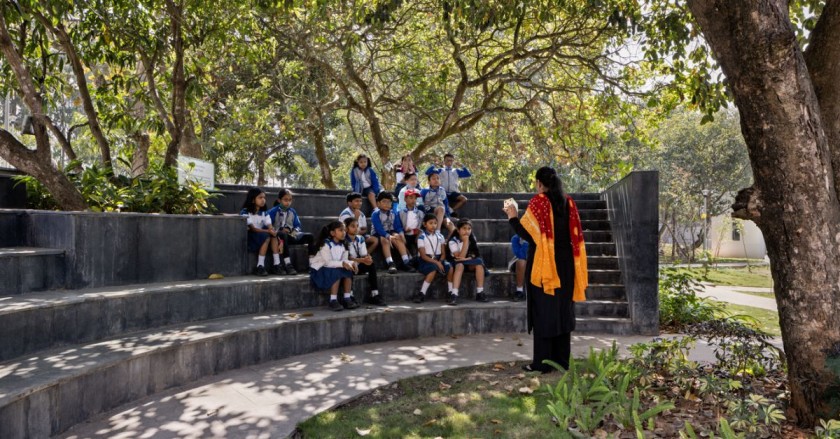
Sheetalakshmi, the principal of the school, believes that it is essential to bring the concept of sustainability to life. “A sustainable world, filled with the blessings and bounty of nature, is the best gift we can leave behind for future generations. At school we subtly sensitise students about the environment through hands-on and thought-provoking activities, by incorporating them into their curriculum,” she says.
“The students have been in awe of the place and have the freedom to move around freely. They are given a scheduled time daily to have outdoor activities, have classroom sessions outside in the SOUL (School Outdoor Learning Hubs), climb trees if they please, and enjoy fresh and clean air and sunlight. If they are learning about fruit-bearing trees then they can see those in real-time in the school which aids their learning,” she adds.
Zaida, a student of Class 8, says, “My school is unlike any other school in the city. We have the opportunity to go outdoors and learn from nature. For example, the concept of rainwater harvesting that we learn in books is right here in the school. We also plant our food near our cafeteria, which gives us an idea of where our food comes from and the hard work involved in growing food. I love how our teachers always give us the time to explore the surroundings.”
Meanwhile, Akanksha and Saurabh believe that the school takes a step forward while going back to the roots. If you found our stories insightful, informative, or even just enjoyable, we invite you to consider making a voluntary payment to support the work we do at The Better India. Your contribution helps us continue producing quality content that educates, inspires, and drives positive change. Choose one of the payment options below for your contribution- By paying for the stories you value, you directly contribute to sustaining our efforts focused on making a difference in the world. Together, let’s ensure that impactful stories continue to be told and shared, enriching lives and communities alike. Thank you for your support. Here are some frequently asked questions you might find helpful to know why you are contributing?

“There are a lot of things we can learn from nature and I believe that if given the opportunity the students will feel inspired to preserve and protect nature. The kids of the upcoming generation lack a connection with the wild and the school helps to forge that connection,” says Saurabh.
(Edited by Divya Sethu)
This story made me
- 97
- 121
- 89
- 167




